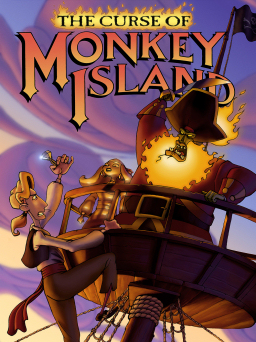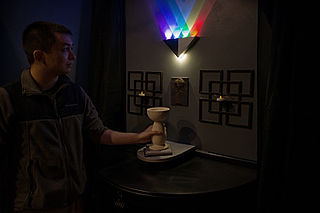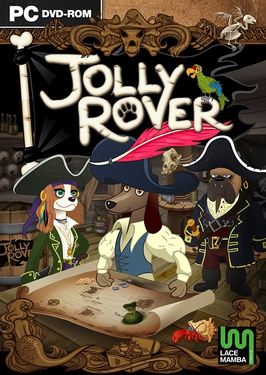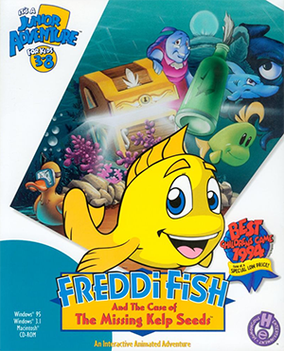
The Curse of Monkey Island is an adventure game developed and published by LucasArts in 1997. A sequel to 1991's Monkey Island 2: LeChuck's Revenge, it is the third game in the Monkey Island series.

The ClueFinders is an educational software series aimed at children aged 8–12 that features a group of mystery-solving teenagers. The series was created by The Learning Company as a counterpart to their Reader Rabbit series for older, elementary-aged students. The series has received praise for its balance of education and entertainment, resulting in numerous awards.

Landstalker: The Treasures of King Nole is an action-adventure game that was developed by Climax Entertainment and released for the Sega Genesis in 1992 in Japan and 1993 elsewhere. Players take on the role of the treasure hunter Nigel as he navigates a three-dimensional world through an isometric viewpoint, solving puzzles and fighting enemies.

Claw is a 2D side-scroller platform video game published by Monolith Productions in 1997 about an anthropomorphic pirate cat who sets on a quest to find an ancient amulet while fighting enemies and solving puzzles. It is Monolith's second release after Blood, which was released that same year in May.

Hergé's Adventures of Tintin is the first animated television series based on Hergé's popular comic book series, The Adventures of Tintin. The series was produced by Belvision Studios and first aired in 1957. After two books were adapted in black and white, eight books were then adapted in colour, each serialised into a set of five-minute episodes, with 103 episodes produced.

Pirate Islands is an Australian children's television program screened on Network Ten in 2003. A sequel called The Lost Treasure of Fiji premiered on Network Ten in 2007.

An escape room video game, also known as escape the room, room escape, or escape game, is a subgenre of point-and-click adventure game which requires a player to escape from imprisonment by exploiting their surroundings. The room usually consists of a locked door, objects to manipulate, and hidden clues or secret compartments. The player must use the objects to interact with other items in the room to reveal a way to escape. Escape the room games were born out of freeware browser games created in Adobe Flash, but have since become most popular as mobile games for iOS and Android. Some examples include Crimson Room, Viridian Room, MOTAS, and Droom. The popularity of these online games has led to the development of real-life escape rooms all around the world.

Disney's Piglet's Big Game is a 2003 action-adventure game developed by French developer Doki Denki Studio and Hulabee Entertainment, and published by Gotham Games, Disney Interactive Studios, and THQ. The game centers around Piglet and how he tries to show how he can help. The game is loosely based on Piglet's Big Movie.

Zack & Wiki: Quest for Barbaros' Treasure is an adventure puzzle video game developed and published by Capcom for the Wii video game console. It was first released in North America on October 23, 2007, and was later released in Japan, PAL regions, and as one of eight Wii launch games in South Korea. The game stars the aspiring pirate Zack and his monkey friend Wiki. Shortly after joining a pirate gang called "The Sea Rabbits", the pair discovers a talking skull belonging to the pirate captain Barbaros. In exchange for helping find all the pieces of the captain's cursed body, Barbaros promises to lead Zack and Wiki to the coveted "Treasure Island" and his legendary pirate ship.

Animal Treasure Island is a 1971 Japanese anime adventure comedy film directed by Hiroshi Ikeda and based on the 1883 novel Treasure Island by Robert Louis Stevenson. The film was produced by Toei Animation and released on the studio's 20th anniversary. It was licensed and distributed in English-language countries by Discotek Media.

The Princess and the Pirate is a 1944 American comedy film directed by David Butler and starring Bob Hope and Virginia Mayo. Based on a story by Sy Bartlett, the film is about a princess who travels incognito to elope with her true love instead of marrying the man to whom she is betrothed. On the high seas, her ship is attacked by pirates who plan to kidnap her and hold her for ransom, unaware that she will be rescued by the unlikeliest of knights errant. Produced by Samuel Goldwyn, The Princess and the Pirate received Academy Award nominations for Best Art Direction and Best Music Score.

Ransom of the Seven Ships is the 20th installment in the Nancy Drew point-and-click adventure game series by Her Interactive. The game is available for play on Microsoft Windows platforms. It has an ESRB rating of E for moments of mild violence and peril. Players take on the first-person view of fictional amateur sleuth Nancy Drew and must solve the mystery through interrogation of suspects, solving puzzles, and discovering clues. There are two levels of gameplay, Junior and Senior detective modes, each offering a different difficulty level of puzzles and hints, however neither of these changes affects the actual plot of the game. The game is loosely based on a book entitled The Broken Anchor (1983).

Star Trek: The Rebel Universe is an action-adventure computer game published by Firebird Software in Europe and Simon & Schuster Interactive in America. It was originally released for the Atari ST in 1987, and was followed the next year with versions for the Commodore 64 and DOS.
Dexter Manley is an American commercial and video game voice actor. He has worked on 300 commercials and 25 video games. He worked extensively for Nintendo, providing voices for many Mario and Donkey Kong games; and for Microsoft, Boeing Company, Alaska Airlines, and others. Manley has also lent his voice twice to the Star Fox series, voicing ROB 64 in Star Fox: Assault. He appeared as a host on 2005 SIGGRAPH meeting, where he discussed voice acting topics. He is the president of Tenacious Media, media and marketing company operating in Seattle, Washington, and is also a film actor, usually filming in independent films.

Jolly Rover is a 2D graphic adventure game developed by Australian studio Brawsome. The game was released in early 2010 for the PC, distributed digitally.
The Phantom Treehouse is a 1984 Australian animated fantasy-adventure film directed by Paul Williams.

Edna & Harvey: Harvey's New Eyes is a point-and-click adventure game created by Daedalic Entertainment. The game was released in Germany on August 26, 2011. Harvey's New Eyes is a sequel to Edna & Harvey: The Breakout.

Freddi Fish and the Case of the Missing Kelp Seeds is a video game developed and published by Humongous Entertainment and the first game released for the Freddi Fish franchise. It was released on October 28, 1994. In 2008, it was released on the Wii under the title Freddi Fish in Kelp Seed Mystery as well as Windows and Macintosh, and on Android with a shortened title Freddi Fish and the Missing Kelp Seeds. The Wii version's availability was limited by legal problems concerning its development. A spin-off handheld LCD game titled Freddi Fish: Jellyfish Jamboree was also released in 1999 that was based on a minigame from Kelp Seeds. A port for the Nintendo Switch will be released on February 29, 2024.

Ollo in the Sunny Valley Fair is a 2002 point-and-click adventure game produced by Hulabee Entertainment and published by Plaid Banana Entertainment.

The Legend of Kyrandia: Book One is a 2D point-and-click adventure game, developed by Westwood Studios and published by Virgin Games in August 1992. The game is the first in the The Legend of Kyrandia series, and focuses on players taking on the role of a young prince who put an end to the tyrannical chaos of an evil court jester.

















